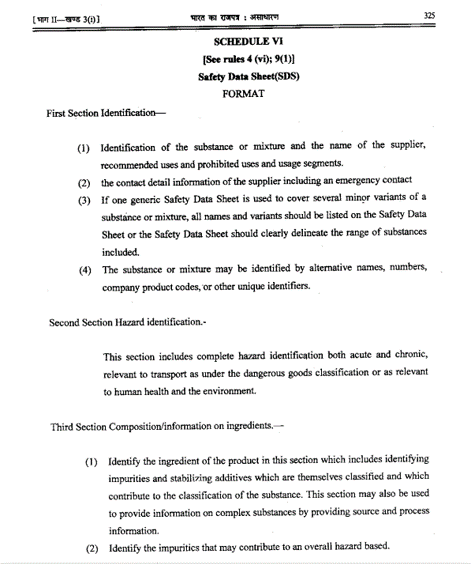Overview of Chemical Regulations in India
Little Pro on 2018-05-21Views: 6648 Update:2018-10-17
There is currently no REACH-like or TSCA-like regulations for chemicals in India. There is no national chemical inventory or any chemical registration requirement either. However, it is misleading to say that there is no chemical regulation in India at all. In this article, we will give you an overview of chemicals-related regulations in India and share with you the latest developments.
Overview of Chemical Regulations in India
The following 2 chemical regulations are the most important ones in force in India. We will take a close look at them one by one.
- Manufacture, Storage And Import Of Hazardous Chemical (Amendment) Rules, 1989, 1994, 2000
- Ozone Depleting Substance (R&C) Rules (2000)
Manufacture, Storage And Import Of Hazardous Chemical (Amendment) Rules, 1989
The regulation was firstly enacted in 1989 by the Ministry of Environment & Forests (MoEF) and later amended in 1994 and 2000. It regulates the manufacture, storage and import of hazardous chemicals in India. The transport of hazardous chemicals must meet the provisions of the Motor Vehicles Act, 1988.
"Hazardous Chemicals " includes 3 schedules. Regulatory requirements are different for each schedule.
- (i) any chemical which satisfies any of the criteria laid down in Part I of Schedule 1 or listed in Part II of this Schedule 1 ;
- (ii) any chemical listed in Column 2 of Schedule 2;
- (iii) any chemical listed in Column 2 of Schedule 3;
Regulations on Schedule 1 Hazardous Chemicals
Schedule 1 consists of two parts: (1) any hazardous chemicals that meet one of the following criteria and (2) 684 named chemical substances listed in Schedule 1.
- Toxic chemicals: oral LD50 <200mg/kg, or dermal LD50 <2,000mg/kg or inhalation LC50 < 10mg/L
- Flammable gases: i.,e gases that are ignitable when in a mixture of 13 percent or less by volume with air
- Flammable liquids: liquids with flash points below than 90 celcius degress
- Explosives
For hazardous chemicals covered in schedule 1, site owners must meet the following obligations:
- identify hazards associated with industrial activity and take adequate steps for prevention and control
- provide relevant information to persons liable to be affected by a major accident
- notify the concerned authorities within 48 hours of the occurrence of a major accident
- provide safety data sheets and label every container of hazardous chemicals.
In addition, any person responsible for importing Schedule 1 hazardous chemicals in India shall provide [before 30 days or as reasonably possible but not later than] the date of import to the Chief Controller Imports & Exports with the information below:
- (i) the name and address of the person receiving the consignment in India;
- (ii) the port of entry in India;
- (iii) mode of transport from the exporting country to India;
- (iv) the quantity of chemical (s) being imported; and
- (v) complete product safety information
Schedule 2 and Schedule 3 Hazardous Chemicals
Schedule 2 and schedule 3 are some hazardous chemicals with assigned threshold quantities. When a site handles a hazardous chemicals more than the thresholds, the site will be regarded as major accident hazards (MAH) installations and subject to reporting, safety audit and contingency plan requirements.
Ozone Depleting Substance (R&C) Rules (2000)
This regulation strictly controls the production, import and use of ozone depleting substances (ODCs) in India. Most of ODCs are banned in India.
The complete list of regulated ODCs and the regulation can be access here.
Latest Developments
In July 2011, the Ministry of Environment and Forests published a draft document called Hazardous Substances (Classification, Packaging and Labelling) Rules, 2011. It is fully assigned with UN GHS. Even though the rules have never officially been adopted, the new 16-section SDS requirements given in the draft document can help you prepare your SDSs for Indian market (see picture below).

To download the draft document, please click here.
The Ministry of Environment, Forest, and Climate Change formed the National Coordination Committee to prepare a National Action Plan for Chemicals for India. It is expected that a draft report be released in the first half of 2018. The report will include plans for the revision of existing chemicals legislation and GHS adoption.
No comments:
Post a Comment